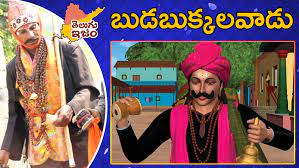Jangara Devaras : Ancient Tradition & Chanting Of Holy & Sacred Hymns
Jangara Devaras : Also known as Jangas, are Shaivite beggars who hold sub-castes such as Minda Jangas, Budige Jangas, and Ganta Jangas. These Jangas are characterized by their unique appearance, including a crown with a Phani chakram, vibhuti lines on the forehead, a belt in the armpit, a brass bell in one hand, and a stick in the other hand. They are accompanied by Jangam Devaras, who serve as their guardians.
On Sankranthi days, a budabukka player arrives in the middle of the night, playing the budabukka (a traditional musical instrument), and departs at dawn. During this time, they blow the conch shell, ring the bell, and glorify Lord Shiva. The budabukka player roams around the village, stopping in front of every house to bless the householders before moving on.
In the past, devotees used to be ecstatic upon seeing the Jangamayyas approaching their houses, blowing conch shells, and holding bells, while chanting “Hara Hara Mahadeva Sambhoshankara.” It is believed that during the time of the Ramayana, Goddess Sita while living in the forest, encountered a Jangandeva in disguise and mistook him for Lord Shiva Himself.
She crossed Lakshmana’s line, thinking it was Lord Shiva before her. If the Jangandevara did not come to a house, it was believed that any auspicious or inauspicious activities should be halted.
The primary occupation of Jangas is performing rituals for the deceased. They conduct these rituals for people from all castes except Brahmins. On the day of performing the ritual, they ring the bell and blow the conch shell before going to the well or pond to immerse the ritualistic items.
Minda Jangas were known as such because they were promiscuous and wandered from house to house. Those who engage with them are called Minda Jangas.
Ganta Jangas, also known as Veera Mushtu Jangas, dress up as Basaveshwara, a prominent figure in Shaivism. They beg from house to house, portraying themselves as Jangam Devaras. They wear an angarkha that is removed from top to bottom, a white headscarf, and a long garment around the neck. They apply vibhuti on their faces and, by ringing the bell and filling the conch shell, they collect alms from each household, imagining themselves as Basaveshwara.
They sing hymns while receiving alms and chanting mantras while spinning a stick around the bell. People of all ages receive vibhuti from them with reverence. Ganta Jangas fulfill their role as propagators of Veera Shaivism.
Jangara Devaras Are storytellers
Who narrate Jangam stories. They use a musical instrument called a Budike, which is made of bronze or brass. The Budike has a cane frame fixed on one side and covered with leather. The storyteller plays the instrument by tapping on the skin with their fingers, creating a humming sound by closing the other side. The Budige Jangam storyteller dresses in a vertical tang wears a turban, anklets, and pearls around their legs, and carries a tambura on their shoulder.
They also wear a bandana on their wrist and tap the tambura strings with their other hand. The storytelling begins with a twist. The audience members follow the storyteller, wearing bells and singing along with the story, playing the bells in accordance with the
rhythm of the song. In between, a comedian cracks jokes to entertain the audience and receives their appreciation.
Also Read : Theppotsavalu : Performed With Ceremonial Idols & Decorated With Beautiful Rafts

